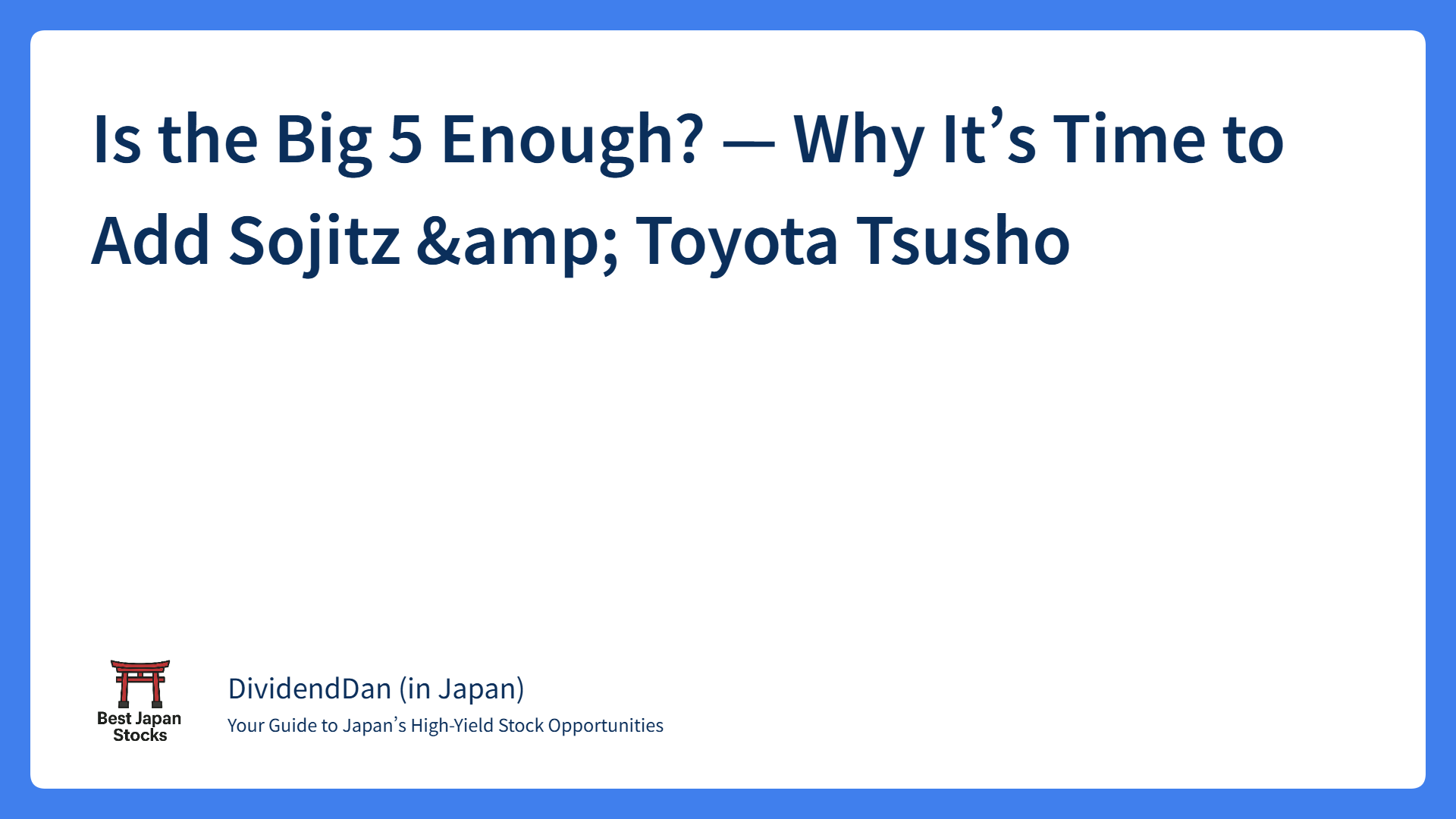Sojitz (2768) High Dividend & Growth Investment Report

① Summary: Is the Stock a Buy Now?
Conclusion of this chapter: Buy on dips when timing allows. The share price stands near its all-time high (¥3,509 at the close on 6 Jun 2025), yet the dividend yield remains attractive at roughly 4.7 %. As Sojitz executes its strategy to reduce resource dependence, accumulating shares below ¥3,300 looks reasonable for long-term income investors.
| Key Points | |
| Share-price trend | COVID-19 low (Mar-2020: ~¥1,300) → Mar-2025: mid-¥3,500s, or about 2.7×. Current ¥3,509 hovers near the record high. |
| Dividend trend | FY2021 ¥10 → FY2026E ¥165; five consecutive hikes. Progressive dividend policy declared. |
| Dividend yield | ¥165 ÷ ¥3,509 ≈ 4.7 %. A 4 % yield would be reached at roughly ¥4,125, above today’s level. |
| PBR | BPS c. ¥2,194 → PBR ~1.6× at ¥3,509. Asset quality is solid (policy stocks, prime Tokyo real estate); headline discount has narrowed. |
| Earnings outlook | Mid-term Plan 2026 targets net profit >¥120 bn and ROE >12 %. Renewables & healthcare expansion should smooth the resource cycle. |
Bottom line: High yield plus growth capex limits downside. A “long-term income and medium-term capital gains” strategy—collect dividends and add on dips—appears effective.
Note for Overseas Investors: Japanese firms often keep high yields yet are conservative on capital policy. Sojitz’s progressive DPS and commitment to PBR >1× demonstrate a shareholder-friendly stance.
② Company Structure & Brand Strength
Corporate outline
- Founded: 2004 via a merger between Nichimen (textiles) and Nissho Iwai (resources)
- Headquarters: Tokyo
- Listing: TSE Prime (Code 2768)
- Employees: ~4,000; >440 consolidated entities across 50+ countries
- Motto: “New way, New value”
- Culture: Young, fast-moving, field-oriented organization emphasizing quick decisions
Diversified portfolio (7 Divisions)
- Automotive
- Aerospace & Social Infrastructure
- Energy & Healthcare
- Metals, Resources & Recycling
- Chemicals
- Consumer Lifestyle & Agribusiness
- Retail & Consumer Services
Resource-driven cash is recycled into non-resource and service sectors, balancing resilience and growth.
Key financials
- Revenue: FY2020 ¥1.8 tn → FY2023 ¥2.48 tn
- Net profit: ¥60.8 bn → record ¥111.2 bn
- FY2025E: Revenue ¥2.5 tn; Net profit ¥110.6 bn
- ROE: Stable at 10–14 %
Brand / Culture / Ownership
- Flat, supportive culture; high discretion for young staff (OpenWork reviews)
- Governance pressure from dispersed institutional ownership and activists; outside-director share rising; buy-backs used to support PBR
Note for Overseas Investors: No founding family; shares are mainly held by trust banks and global managers—governance transparency is high, though segment disclosure is less granular than at US peers.
③ Share-price Trend & Market View
Chapter conclusion: Even at all-time highs, with PER ~6.8× and PBR 1.6×, Sojitz still trades at a discount. Progressive dividends and buy-backs underpin the downside, while commodity prices and mid-plan execution drive volatility. Sub-¥3,000 has historically been a classic buying zone.
- Five-year chart: ¥1,300 COVID low → >¥3,500 (Mar-2023) → ¥3,509 now.
- Valuation: FY2025E EPS ¥513.7 → PER 6.8× vs. TOPIX trading-house average 8–9×.
- Major events:
• May-2023 record profit → sharp rally
• Oct-2024 guidance cut → –8 % drop
• May-2025 ¥10 bn buy-back → recovery to highs - Current range:
• Resistance: 4 % yield line ≈ ¥4,125
• Support: around ¥3,000 (dividend floor)
Tip: Annotate earnings surprises and buy-back announcements on charts to reveal behavioral patterns for global readers.
Note: Low multiples reflect partial commodity exposure—monitor iron-ore & coal prices.
④ Growth Potential & Risks: Can It Deliver?
Chapter conclusion: Accelerating investment into non-resource segments should stabilise earnings, yet resource price swings and ramp-up delays remain risks. Maintaining ROE >10 % is key for rerating.
Growth story (Mid-Plan 2026)
- ¥300 bn growth capex; ~70 % allocated to EVs, renewables, healthcare, recycling
- Non-resource profit ratio: 45 % → 60 %
- Projects: EV supply chain, 1.5 GW renewables, ASEAN hospital PPPs, urban-mine recycling
Numerical targets
- FY2025 net profit ¥120 bn
- ROE 12 %
- CROIC >8 %
- Net D/E ≤1.0×
Drivers & risks
| Category | High | Medium | Low |
| Growth | Renewables expansion / EV materials | Recycling / Hospital operations | Legacy trading |
| Risk | Commodity downturn | New-business ramp-up delay | Interest-rate hikes |
⑤ Dividend Strategy: Stability & Upside
Chapter conclusion: Progressive DPS plus agile buy-backs combine high yield with capital efficiency. DPS CAGR ~18 %; cut risk is low while cash generation remains solid.
| FY | DPS (¥) | Payout Ratio |
| 2021 | 85 | 32 % |
| 2022 | 110 | 32 % |
| 2023 | 130 | 33 % |
| 2024 | 150 | 34 % |
| 2025E | 165 | 35 % |
Progressive dividend declared since FY2021 (no cuts)- Buy-backs: ¥20 bn in 2023; ¥10 bn in 2025
- Total return target: 40–50 %
Note: Japanese “progressive” dividends resemble UK practice; always check cash-flow cover.
⑥ PBR & Asset Quality: Still Cheap?
Chapter conclusion: PBR 1.6× (vs. Big-5 average 1.3×) commands a modest premium, but over half of equity sits in liquid hard assets; adjusting for hidden reserves leaves further upside.
Indicative equity breakdown
| Item | Share | Comment |
| Cash & Securities | 22 % | Policy-stock reduction in progress |
| Real estate | 18 % | Prime Tokyo offices/retail, realised gains recorded |
| Resource interests | 21 % | Australian coal/copper; cyclical exposure |
| Operating investments | 39 % | Renewables, healthcare, retail subsidiaries |
Efficiency initiatives
- Policy-stock sales: ~¥30 bn in 2023-25
- Real-estate recycling: low-yield assets → Tokyo & global logistics
- ROE 12 % commitment to sustain PBR >1×
Note: Japanese trading houses carry real estate and equities at historical cost—mark-to-market would lower the effective PBR.
⑦ Disclaimer
This report is for general informational purposes only, based on public data and the author’s opinions. It does not constitute investment advice or a solicitation to trade securities. Always make investment decisions at your own risk, consulting licensed professionals where appropriate. Figures are current as of 9 Jun 2025 and may change in the future.



